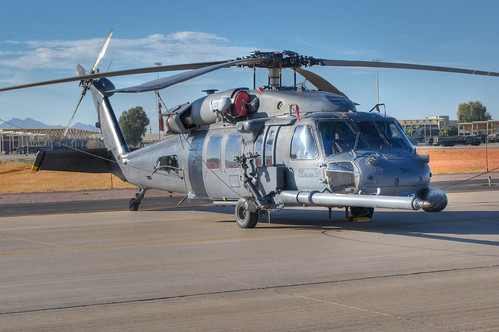HH-60 cockpit
BAGRAM AIR FIELD, Afghanistan - Capt. Tamar Hassan, an HH-60 Pave Hawk pilot, runs through his preflight checks on the aircraft prior to a training mission at Bagram Air Field, Afghanistan, April 20
Panning the Hindu Kush mountains Parwan, Afghanistan - April 2009
A 33rd Rescue Squadron HH-60G takes off from the USS Juneau during ship landing training in the Pacific.



BALAD AIR BASE, Iraq -- An Air Force pararescueman drops from an HH-60G Pave Hawk helicopter
In flight air refueling between an HH-60g Pave Hawk
Members of the U.S. Coast Guard Maritime Safety and Security Team 91105 descend from a U.S. Air Force HH-60G Pave Hawk
Pararescue men from the 48th Rescue Squadron climb up a rope ladder attached to a HH-60 Pave Hawk
The wiki Sikorsky HH-60G Pave Hawk is a twin turboshaft engine helicopter in service with the United States Air Force. It is a derivative of the UH-60 Black Hawk and the US Air Force PAVE electronic systems program. The HH-60 is a member of the Sikorsky S-70 family
The HH-60G's primary wartime mission is combat search and rescue, infiltration, exfiltration and resupply of special operations forces in day, night or marginal weather conditions.
The HH-60G is equipped with an all-weather radar which enables the crew to avoid inclement weather.
To extend their range, Pave Hawks are equipped with a retractable in-flight refueling probe and internal auxiliary fuel tanks. Pave Hawks are equipped with a rescue hoist with a 200-foot (60.7 meters) cable and 600-pound (270 kilograms) lift capacity.
All HH-60G's have an automatic flight control system to stabilize the aircraft in typical flight altitudes. They also have instrumentation and engine and rotor blade anti-ice systems for all-weather operation.
The non-retractable landing gear consists of two main landing gears and a tail wheel. Aft sliding doors on each side of the troop and cargo compartment allow rapid loading and unloading. External loads can be carried on an 8,000-pound (3,600 kilograms) capacity cargo hook.
Pave Hawks are equipped with folding rotor blades and a tail stabilator for shipboard operations and to ease air transportability. The Pave Hawk is equipped with two crew-served 7.62mm miniguns mounted in the cabin windows. Also, two .50 caliber machine guns can be mounted in the cabin doors. The Pave Hawk can be equipped with the external stores support system. The aircraft can also carry eight to 10 troops. (U.S. Air Force Photo)

























1 comments:
A Retractable Gate is ideal for homes or commercial areas that require medium security levels. They are ideal to provide utmost security and strength as they are generally made of galvanized steel. They are designed in a way that light and fresh air can come in without compromising on the security or letting intruders in and have multiple locking options.
ac
Post a Comment